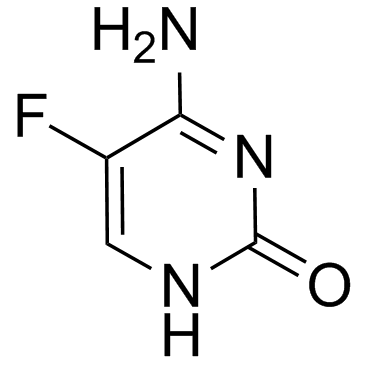5-Flucytosine

5-Flucytosine structure
|
Common Name | 5-Flucytosine | ||
|---|---|---|---|---|
| CAS Number | 2022-85-7 | Molecular Weight | 129.092 | |
| Density | 1.7±0.1 g/cm3 | Boiling Point | 298ºC | |
| Molecular Formula | C4H4FN3O | Melting Point | 298-300 °C (dec.)(lit.) | |
| MSDS | Chinese USA | Flash Point | N/A | |
| Symbol |

GHS08 |
Signal Word | Warning | |
|
The mannoprotein TIR3 (CAGL0C03872g) is required for sterol uptake in Candida glabrata.
Biochim. Biophys. Acta 1851(2) , 141-51, (2015) Sterol uptake in the pathogenic fungus, Candida glabrata, occurs via the sterol transporter, CgAus1p. Azole inhibition of sterol biosynthesis can under certain circumstances be reversed by adding exogenously sterol. Here we demonstrate that the CgTIR3 (CAGL0C... |
|
|
Cheminformatics analysis of assertions mined from literature that describe drug-induced liver injury in different species.
Chem. Res. Toxicol. 23 , 171-83, (2010) Drug-induced liver injury is one of the main causes of drug attrition. The ability to predict the liver effects of drug candidates from their chemical structures is critical to help guide experimental drug discovery projects toward safer medicines. In this st... |
|
|
Translating clinical findings into knowledge in drug safety evaluation--drug induced liver injury prediction system (DILIps).
J. Sci. Ind. Res. 65(10) , 808, (2006) Drug-induced liver injury (DILI) is a significant concern in drug development due to the poor concordance between preclinical and clinical findings of liver toxicity. We hypothesized that the DILI types (hepatotoxic side effects) seen in the clinic can be tra... |
|
|
Developing structure-activity relationships for the prediction of hepatotoxicity.
Chem. Res. Toxicol. 23 , 1215-22, (2010) Drug-induced liver injury is a major issue of concern and has led to the withdrawal of a significant number of marketed drugs. An understanding of structure-activity relationships (SARs) of chemicals can make a significant contribution to the identification o... |
|
|
A predictive ligand-based Bayesian model for human drug-induced liver injury.
Drug Metab. Dispos. 38 , 2302-8, (2010) Drug-induced liver injury (DILI) is one of the most important reasons for drug development failure at both preapproval and postapproval stages. There has been increased interest in developing predictive in vivo, in vitro, and in silico models to identify comp... |
|
|
Hologram QSAR model for the prediction of human oral bioavailability.
Bioorg. Med. Chem. 15 , 7738-45, (2007) A drug intended for use in humans should have an ideal balance of pharmacokinetics and safety, as well as potency and selectivity. Unfavorable pharmacokinetics can negatively affect the clinical development of many otherwise promising drug candidates. A varie... |
|
|
Quantitative structure-activity relationship and complex network approach to monoamine oxidase A and B inhibitors.
J. Med. Chem. 51 , 6740-51, (2008) The work provides a new model for the prediction of the MAO-A and -B inhibitor activity by the use of combined complex networks and QSAR methodologies. On the basis of the obtained model, we prepared and assayed 33 coumarin derivatives, and the theoretical pr... |
|
|
Mechanisms of azole resistance in Candida albicans clinical isolates from Shanghai, China.
Res. Microbiol. 166 , 153-61, (2015) This study was undertaken to characterize the mechanism(s) of azole resistance in clinical isolates of Candida albicans collected in Shanghai, China, focusing on the role of efflux pumps, target enzymes of fluconazole (Erg11), respiratory status and the ergos... |
|
|
Treating cryptococcal meningitis in people with HIV.
BMJ 346 , f2203, (2013)
|
|
|
Combination antifungal therapy for cryptococcal meningitis.
N. Engl. J. Med. 368(14) , 1291-302, (2013) Combination antifungal therapy (amphotericin B deoxycholate and flucytosine) is the recommended treatment for cryptococcal meningitis but has not been shown to reduce mortality, as compared with amphotericin B alone. We performed a randomized, controlled tria... |